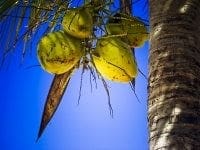The Island of Hawaii is the only island to have white, black and green sand beaches. The green sand beach is south of Volcano Village on Route 11. Turn left at the South Point Road (between mile markers #69 and #70). About 11 miles from the turnoff you will pass some abandoned buildings and come to a fork in the road. Continue straight ahead to South Point. This area is the recommended location in which to park your vehicle and there is no charge for parking. From the Kaulana Boat Launch, and keeping within sight of the shore, it is approximately 2 & 1/4 miles to the Green Sand Beach (1-hour hike, one-way). Plan to walk unless you are prepared with a 4WD vehicle. Once at this littoral cone, carefully choose the path to the beach. The green sand owes its color and name to a large deposit of a semi-precious gem called olivine, sometimes referred to as the “Hawaiian Diamond.” Papakolea Beach (Green Sands Beach) is located in a bay circled by Pu`u Mahana, a cinder cone formed over 49,000 years ago and associated with the southwest rift of Mauna Loa. Since its last eruption, the cinder cone has partially collapsed and been partially eroded by the ocean.
The cinder cone is rich in olivine, a silicate mineral containing iron and magnesium, also known as peridot when of gem quality. Olivine is a common mineral component of Hawaiian lavas and one of the first crystals to form as magma cools. Olivine is locally known as “Hawaiian Diamond” and is notably found in O`ahu’s famous Diamond Head landmark. The source of the green coloration of the beach sands is due to the olivine crystals which are winnowed from the eroding headland by the action of the sea. Olivine, being denser and tougher than the ash fragments, glass and black pyroxene of the rest of the rocks and lava flows, tends to accumulate on the beach whereas the usual volcanic sand is swept out to sea. Although these crystals are eventually washed away as well, the constant erosion of the cinder cone ensures a steady supply of sand for the foreseeable future. Eventually, however, the supply will run out and the beach will look like any other.

